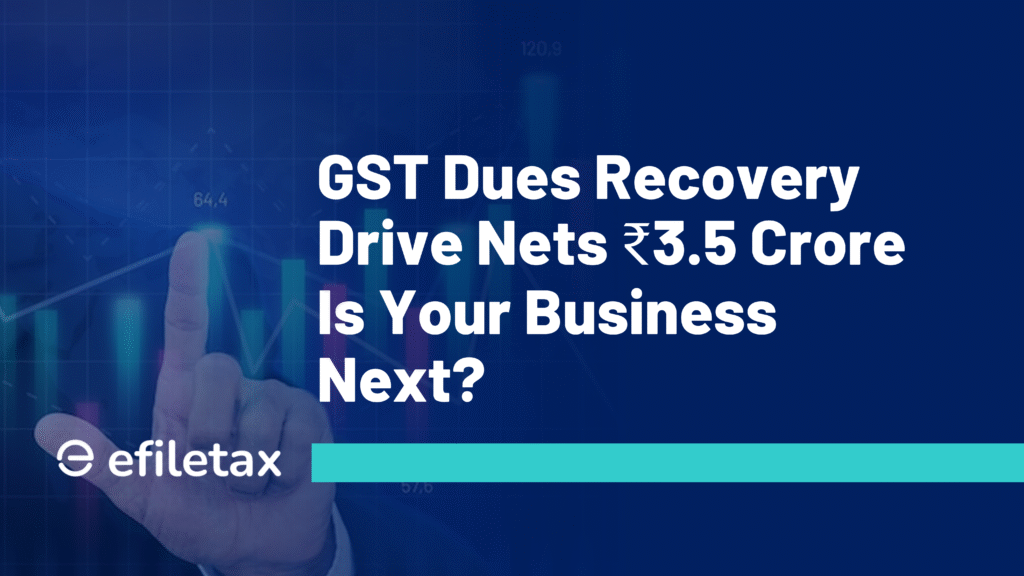
GST arrears recovery nets ₹3.5 crore What taxpayers should know
In a recent enforcement push, GST authorities recovered ₹3.5 crore in pending tax dues. The drive primarily targeted non-filers and defaulters from FY 2017–18 to 2019–20. This follows a broader national campaign to clean up old liabilities ahead of the GST Amnesty Scheme deadlines.
If you’re a small business, trader, or GST-registered entity with past defaults, here’s what this recovery means for you — and how you can avoid penalties.
Why GST authorities intensified recovery actions
As per official press releases and GSTN data, several taxpayers who defaulted between FY 2017–18 to 2019–20 were still non-compliant despite multiple notices. The ₹3.5 crore recovered is only a part of the larger action plan led by State GST departments across India.
Key reasons for the recent recovery drive:
- Closure of older cases before the GST Amnesty Scheme deadline
- Enforcement of Rule 142 under CGST Rules (issue of demand notices)
- Boosting revenue collections for States
- Identifying inoperative or non-filing GSTINs
GST arrears recovery drive: Who’s affected?
The enforcement drive mainly targeted:
- Non-filers of GSTR-3B or GSTR-9 from FY 2017–18 to FY 2019–20
- Businesses whose GST registrations were cancelled due to non-filing
- Defaulters who ignored earlier notices or DRC-01 under Section 73 or 74
- Entities showing mismatches between turnover and GST paid
If your business hasn’t filed returns for the above years or has dues pending, it’s advisable to act now.
GST Amnesty Scheme: Still a window of relief
While recovery actions are ongoing, taxpayers can still benefit from the GST Amnesty Scheme 2025 under Section 128A of the CGST Act (inserted via Finance Act, 2023 and made effective in 2025).
Here’s what you get:
| Criteria | Before Amnesty | With Amnesty (Sec 128A) |
|---|---|---|
| Late fee for GSTR-9 (FY18–20) | ₹10,000+ | Capped at ₹500 per return |
| Late fee for GSTR-10 | ₹200 per day | Capped at ₹1,000 |
| Cancellation of GSTIN | After 6+ months of default | Can apply for revocation till 31.07.2025 |
| GSTR-4 late fee | ₹5,000+ | Reduced to ₹500 per return |
🔗 CBIC Amnesty Notification No. 03/2023-Central Tax dated 31.03.2023
Expert View: Why timely compliance matters
CA Rajiv Mehta, a GST practitioner from Mumbai, says:
“Many small businesses ignored filing from 2018–2020 assuming the government won’t act on old dues. This recovery drive is proof that non-compliance is risky — especially now that systems are integrated and AI-based notices are increasing.”
His tip: Use the amnesty scheme if eligible — pay reduced fees and clean your records before July 31, 2025.
How Efiletax can help
At Efiletax, we assist businesses in:
- Filing pending GSTR-3B, GSTR-9, GSTR-4 or GSTR-10
- Checking your GST compliance status
- Applying for GSTIN revocation under the amnesty
- Responding to DRC-01/DRC-07 notices
📞 Don’t wait for a notice — Contact us today and regularize your GST status.
FAQs
Q1. What happens if I don’t respond to a DRC notice?
You may face penalty, interest, and even provisional attachment of bank accounts under Section 83 of the CGST Act.
Q2. Can I still file old GST returns from 2018 or 2019?
Yes, under the GST Amnesty Scheme 2025, you can file returns till 31.07.2025 with reduced late fees.
Q3. I closed my business but didn’t file GSTR-10. What to do?
You should file GSTR-10 with reduced late fees under the amnesty scheme and avoid further penalties.
Summary
GST authorities have recovered ₹3.5 crore in dues from past defaulters in a fresh enforcement drive. If you missed filing GST returns for FY 2017–18 to 2019–20, act fast under the GST Amnesty Scheme 2025 to avoid penalties. Deadline: July 31, 2025.
Closing CTA:
📢 Missed GST filings from past years? The government is cracking down. Use the 2025 Amnesty Scheme to clean your record — before enforcement reaches you.